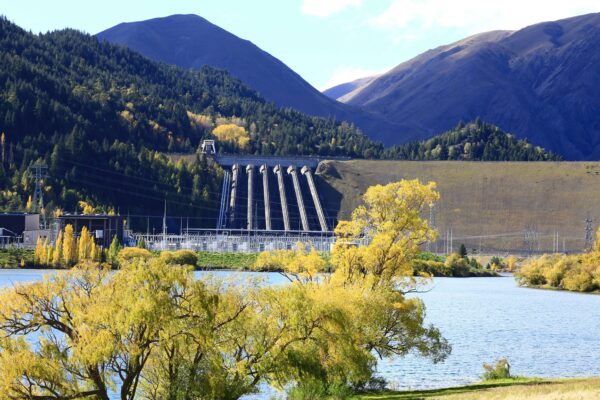Submission in Response to New Zealand’s second emissions reduction plan (ERP2)
Scope of submission
This submission relates to information given in the Ministry for the Environment discussion document regarding the currently proposed second plan to reduce New Zealand’s emissions - New Zealand’s second emissions reduction plan, July 2024 (draft ERP2). It also covers other matters relevant to reducing our emissions.
Because we consider that the issues which need to be addressed are much broader than are covered by specific questions raised in the discussion document, we have not attempted to provide direct answers to most of those, but rather have supplied information that we hope will allow appropriate steps to be taken to seriously improve the proposed emissions reduction plan.
1. Urgent action needed to reduce our emissions
Global warming, caused by human-generated emissions into the atmosphere, is a critically serious problem that could lead to significant regions of the earth becoming uninhabitable or unable to supply food, sea level rise that could submerge large areas of land, including towns and cities, and the extinction of many species, both on land and in fresh water and oceans.
In the draft ERP2 the Emissions Trading Scheme (ETS), enacted in 2008, has remained the primary tool to reduce emissions, but so far we have not seen any significant emissions reductions from it. After continuing to increase during the early years of the ETS, the 2022 emissions figures show a slight decrease compared to previous years, but the ETS played only a minor role compared to the full hydro-lakes and the aftermath of COVID19.
New Zealand’s very weak efforts so far to reduce emissions have been rated by Climate Tracker as “highly insufficient”. Climate Tracker is an independent scientific project that tracks government climate action and measures it against the globally agreed Paris Agreement aim of "holding warming well below 2°C, and pursuing efforts to limit warming to 1.5°C."
1.1 The relevance of the ETS versus other tools
The ETS has been promoted in the draft ERP2 as the main tool to drive emissions down. However, a market-based tool like the ETS is unlikely to be as effective as setting standards and phase-out dates through legislation. The discussion document states its belief in the market and rejects, to a large extent, Government intervention.
One legislative step that was taken in the past was in July 2023, when the previous government brought in requirements that no new low- or medium-temperature coal fired boilers be installed, and that existing boilers of this type be phased out by the end of 2037. The problem here is that the 2037 phase-out date is too slow. The IPCC 2022 AR6 report calls for global coal use to be reduced by nearly 75% over the 2020-2030 period, and 96% by 2040. Meeting this challenge will probably require the phase-out of coal fired boilers by 2030 at the latest, because reducing coal use for some other processes, such as steel making, is much more challenging.
Our reliance primarily on the market approach and the ETS has been the cause of New Zealand’s failure to curb emissions, which are amongst the highest per capita in the OECD. On the other hand, legislating standards and appropriate phase-out dates would create strong incentives to help us meet specified targets, just as they were in the successful phase-out of CFCs (chlorofluorocarbons).
We recommend that the government seriously consider legislative approaches such as introducing vehicle emission standards, clean car discounts, a more rapid phase-out date for coal use, and other steps, and not reject them for purely ideological reasons.
1.2 The role of technology
Regarding technology, we favour the approach of the Climate Change Commission (CCC) which, in its advice to the government and its forecasting, only relies on proven technology that is available today. Any new technological developments that might come to flourish in the near future are seen as a bonus and a de-risking of the forecast, but are not relied upon.
The draft ERP2 deviates from this approach and considers technological developments that might or might not eventuate. In the area of agriculture, for example, it anticipates potential emissions reductions for which the research is not yet conclusive.
We recommend that the ERP2 goes back to relying on sound accounting practices where decisions are made based on proven facts and knowledge.
1.3 The least cost approach
The discussion document frequently states a desire to apply a ‘least cost’ approach. While it is important to try and not waste expenditure, adopting the ‘least cost’ approach as a prime guiding principle seems to lead to short sighted thinking. For example, if New Zealand decides today to risk remaining with its low emissions reduction targets, it might be penalised in international trades tomorrow. The question also has to be asked, least cost to whom? The draft document has scrapped any reference to product stewardship schemes and a "right to repair legislation", which might increase costs to and reduce profits of manufacturers, but will certainly favour New Zealand’s citizens and reduce emissions.
We recommend that the ‘least cost’ approach not be adopted. It might be cost-effective to manufacturers today, but will almost certainly lead to more obsolescence and emissions tomorrow, and higher costs to consumers.

2. Proposed price path for carbon charges is far too low
On page 22 of the discussion document it says:
“Our climate strategy is about New Zealand reaching its economic, social and environmental potential by:
- Taking proactive steps to reduce net greenhouse gas emissions at least cost
- Adapting to the effects of a changing climate.”
Following on from this, regarding proposed carbon charges under the ETS, on page 33 it says:
“The modelling assumes a price path in which prices continue to rise to $75 per tonne in 2028 but then fall to a long-run price of $50 per tonne (in 2023 dollar values) from 2035.”
2.1 Higher charges needed to drive emission reductions
Higher carbon charges are needed to drive many businesses into lower emissions options. They are normally well aware of the need to reduce their emissions, but doing so would typically require capital expenditure and reduce the profitability they are able to achieve at current carbon charge levels.
For example, Fonterra is one of our largest coal users, but currently has a very weak target of quitting coal use by 2037, and has so far only taken very small steps to move to other options for the supply of process heat – electricity and wood biomass. One of the ESR members was also a member of the Auckland Coal Action organisation, who were told in meetings with Fonterra executives that higher carbon charges were what was needed to speed up Fonterra’s move away from coal use.
Considerably higher carbon charges can be expected to substantially accelerate the reduction of coal use by Fonterra, and by other organisations using it as a low- or medium-temperature process heat source. Our current estimate is that these charges will need to be well over $100 / tonne CO2, though this estimate will rise if coal prices fall or electricity prices rise. Some other coal users, such as cement and steel manufacturers, will probably need much higher carbon charges than this, if we just rely on the ETS to drive emissions reductions.
Given that the Government’s plan is to rely primarily on the ETS to reduce emissions, the currently proposed low levels of carbon charges are an appalling weakness. We need to be moving to much higher charge levels that will incentivise businesses to take the necessary steps to achieve significant reductions in their emissions.
2.2 Charges are lower than in many other developed countries
Our carbon charge has recently been around $50 / tonne CO2 (26 July 2024). This is a lot lower than the charges in many other developed countries that are also attempting to achieve the same IPCC (Intergovernmental Panel on Climate Change) 2030 emissions reduction goals as we are.
For example, during the first 6 months of 2024 the EU ETS carbon charge has been around NZ$104, recently NZ$129 on 1 Aug 2024, and Sweden’s carbon tax has been around NZ$216. Over the 1990 to 2021 period, Sweden’s gross emissions fell by around 33%, while ours increased by around 19%. More detailed information on carbon charges in other countries is available in US$ on the following site:
https://www.visualcapitalist.com/sp/visualized-the-price-of-carbon-around-the-world-in-2024/
Some countries are planning to put financial border adjustments on imported goods coming from countries with lower carbon charges. For example, the EU is in the process of introducing a Carbon Border Adjustment Mechanism (CBAM) that is due to be fully in place by 2026. Initially it is planned to apply this only to goods whose production is carbon intensive, but to then expand its coverage to other items. With the CBAM in place, the importation of some items into Europe will require the purchase and surrender of CBAM certificates to account for the difference in carbon charges between the EU and the country where the goods were produced.
If we stay with the currently proposed low carbon prices, we can expect serious repercussions in our trading with other countries that have priced carbon more appropriately. To avoid the risk of paying border adjustment fees on exports, we need to at least match the carbon charges in the countries we export to.
2.3 Charges are currently way below emissions damage cost
There have been lots of figures published for the cost of the damage that emissions are causing, some of which are very high, but one that has been regularly referred to is the US Environmental Protection Agency figure of US$190 / ton CO2, provided in December 2023. After converting US tons to metric tonnes and US$ to NZ$ (based on July 2024 figures), this gives a damage cost of NZ$336 / tonne CO2. This is the estimated real cost of the damage, which will be borne by the public and seriously affect all of us.
What this means is that New Zealand businesses are being massively subsidised for the damage their emissions are causing. Based on the EPA figures, damage costs are nearly seven times higher than recent emissions charges of around $50 / tonne CO2. Subsidising damage is not a good way forward.
2.4 Assistance to businesses
Higher carbon charges will result in larger amounts of revenue flowing to the Government, but some businesses will struggle financially to make the changes needed to reduce their emissions, and the carbon charges they are encountering.
With higher carbon charges, we recommend that some of the revenue consequently received by the Government be used to financially assist business with making the changes needed to reduce their emissions, so that they can remain operational.

3. Holding down the carbon price with exotic afforestation is not the answer
3.1 Exotic forests do not give long-term carbon capture
Establishing forests to increase timber production may be profitable for owners, but the discussion document is proposing a major creation of new exotic forests to hold the carbon price down. This can push down net emissions in the short term because, under the ETS, registered forest owners can apply to receive carbon credits while their forests grow. But when the forests are harvested – typically after 30-35 years for pinus radiata, our most common forestry tree – the credits need to be repaid, the net emissions figures rise, and the timber goes down a path of starting to release its captured carbon.
This temporary net reduction is proposed under the ERP2 as a means to effectively delay gross emissions reductions, meaning just that a more rapid and drastic transition will be required in around 30 years time, which New Zealand businesses will struggle to make.
The reduction in our net emissions resulting from exotic forest planting will all be reversed when the forests are harvested. This could have serious effects on meeting future budgets. Instead, we need to reduce emissions from the sources that are generating them. This essentially means that we need to take serious steps now to reduce gross emissions. Planting timber forests does not contribute to achieving this.
3.2 Exotic forests are at risk from fires, and also from pests and diseases
Based on experience so far, exotic forests, such as pine or eucalyptus, are much more in danger of being affected by forest fires than native forests are. With the planet warming, the world is already experiencing serious problems with these sorts of forest fires, which besides taking climate change in the wrong direction, also often cause serious problems for surrounding neighbourhoods. Monoculture forests are also more susceptible to pests and diseases.
These are further reasons why planting exotic forests in order to achieve a short-term reduction in net emissions does not make good sense, particularly if these forests are planted onto areas that were previously used for agricultural purposes.
3.3 Receipt and repayment of emissions fees
We understand that currently, when a forest is harvested, the forest owners must return the carbon credit units they have received while the forest was growing, or if these have been sold, purchase back the same number of units and return them. If the units were sold, and the fees have risen significantly while the forest has grown (which is expected, given our current drastic undercharging), this could be a major problem for them.
Because carbon capture in forests that have been planted for harvesting is only temporary, it would be simpler to just remove the provision of units when the forests are growing, and the need to repay them at harvest time. If the provision of carbon credit units is to remain, then we recommend that forest owners be required to pay back only the value of these units at the time they were received, and not at the market rate at the time of harvest.
3.4 Planting native forests is a good way forward
There are many areas where the re-establishment of native forests would make a lot of sense, for example steep areas that were cleared for farm land but are now prone to lots of slips and soil erosion, and also areas along the banks of rivers and streams. Native forests that are re-established and exist into perpetuity are an effective way of increasing carbon capture and hence reducing net emissions.
We recommend that active steps be taken to restore native forests, and also to restore wetland areas where not very successful attempts were previously made to bring them into pasture.
4. Problems with the ETS and other options
If New Zealand is going to keep relying on the ETS as the main tool to drive emissions reductions, then besides the need for higher emissions charges, there are other issues that need to be sorted out. The term ‘units’ refers to emission units that can be traded under the NZ Emissions Trading Register, with one surrendered for each tonne of CO2-equivalent produced.
4.1 Stability of pricing of emissions units
The cost of units currently fluctuates considerably, so there is no clear information for businesses and other entities as to what future emissions charges to expect. For example, it hit a high of $88 on 16 Nov 2022, was recently down to $45 on 25 May 2024, but is currently sitting at around $50 (26 July 2024)
We need to move to a system under which current emissions charges are reasonably stable, and future emissions charges are clearly indicated for coming periods, so businesses and other entities can plan ahead, and take effective action.
4.2 Revenue received from the sale of emissions units
Currently some of the revenue from the sale of emissions units goes to the Government and a significant part goes to other entities that are selling off units that they have recently received, or that have been ‘stockpiled’.
We need to move to a system under which the Government will receive all or virtually all the revenue from the sale of emissions units. This will give it the necessary revenue to help compensate the public for the rising costs of goods and services resulting from higher emissions charges, with some revenue also available to assist businesses and other entities in reducing their emissions.
4.3 Reduction of the number of emissions units
According to the Climate Change Commission, there are currently too many emissions units available to allow the ETS to work effectively. This is one reason why auction prices for units frequently fall below the price levels planned by the Government to control emissions, and as a result the incentive to reduce emissions falls off and Government revenue from unit sales is reduced. It is one of the key problems with the current ETS.
We strongly agree with the CCC’s recent advice that it is critical that the Government reduce the ETS unit volume as soon as possible, and bring the price settings back into alignment with emissions reduction goals. We further recommend that the Government buys back these units at the price originally paid for them, or if that is not workable, then at the unit price in the period before the buy-back starts.
4.4 Reduction in the provision of free allocations of emissions units
Some organisations that are involved in what are categorised as ‘emissions intensive’ or ‘trade-exposed’ (EITE) activities, receive a free allocation of emissions units. Our understanding is that these free units are just effectively new units that the Government creates, and hence the total number of units available is increased.
The Sustainability Council and others have argued that the allocation of free units to emitters is too costly because the Government receives no revenue from them. The allocation of these free units is also removing the financial incentive a carbon charge would provide for the receiving organisations to reduce their emissions.
We recommend that considerably stronger steps be taken to reduce the number of freely allocated units. A workable alternative is to start charging for some or all of the emissions from an entity currently receiving a free allocation, and instead provide Government financial support to the entity so that it can take steps to reduce its emissions.
In order to stop the increase in total units available that the provision of free units currently causes, we further recommend that the free units become units of a different category, which are just returned back by the receiving organisations as their emissions are made, and are not otherwise exchangeable or saleable on the carbon market.
4.5 The simple carbon tax option
A simple carbon tax, as was introduced in Sweden in 1991 to cover part of its emissions, would give much clearer price signals than our current ETS, and would also be much simpler and cheaper to operate. During the first 6 months of 2024, the Swedish tax has been at the equivalent of around NZ$216. Over the 1990 to 2021 period, Sweden’s gross emissions fell by around 33%, while ours increased by around 19%.
We need to seriously consider moving to a simple carbon tax system, rather than the complexities and lack of pricing clarity with our current ETS.
5. Action needed to protect public from rising costs of goods and services
Higher carbon charges will push up the price of goods and services. To make this workable, US climate scientist James Hansen and others have recommended introducing a citizen’s dividend, funded by the revenue the government receives from carbon charges. All citizens and legal residents receive a regular dividend, with smaller payments made in relation to children.
The citizen’s dividend or bonus approach has already been introduced in Switzerland, Canada and Austria, and was earlier proposed in New Zealand by the Green Party, and more recently by the Act Party.
We strongly recommend that a citizen’s dividend be promptly introduced to help compensate the public for the increased costs of goods and services that carbon charges have already caused, and for the rising costs that will result from higher carbon charges, with a major part of the carbon charge revenue used in this way. A smaller amount can also be used to assist organisations in reducing their emissions.
Taking this step will also be a small move towards addressing the rising income inequality that we have experienced over the past 40 years, which has had serious negative effects on our society.
6. Clarity needed in net emissions measurements
The Government has recently moved to using a ‘target accounting’ measure for net emissions, which differs from the standard net measurement used by the IPCC and most other countries. The Climate Change Commission has gone along with the Government’s choice, despite saying that it’s high-level objective for accounting is: “A robust, transparent accounting system which tracks genuine environmental gains while balancing completeness with practicality”. (Ref: https://www.climatecommission.govt.nz/public/Evidence-21/Evidence-CH-03-how-to-measure-progress.pdf)
These target accounting net emissions figures are certainly not transparent, because how they are determined is not clearly explained. The Climate Change Commission itself has said that, because there were no official estimates for target accounting net emissions up to 2022, it had to use other data to try and estimate them, which it says: “is a key caveat to our findings on how Aotearoa New Zealand is currently tracking towards meeting the first emissions budget”. (Ref: https://www.climatecommission.govt.nz/our-work/monitoring/emissions-reduction-monitoring/erm-2024/erm-2024-summary/).
This lack of information and clarity means that few people are able to accurately assess how New Zealand’s planned emissions reductions compare with those of other countries, or how they compare with reduction goals that the IPCC and others have presented.
While there may be some arguments for using the target net method of expressing net emissions, its adoption may also have been motivated as a way of making New Zealand’s emissions reduction figures look stronger than they actually are, and harder to compare with the achievements of other countries and with internationally-set targets.
We need to immediately abandon this obfuscation, and start expressing both our current net emissions and our future net goals in terms of the standard net emissions measurements.

7. Meeting IPCC goals and NDC targets
Comparing our emissions reductions targets with what is needed to meet IPCC goals and NDC targets is not straightforward, primarily because of the obfuscated target accounting measure of net emissions that we currently use. Information compiled by Dr Geoff Bertram from various sources was used for this purpose.
7.1 Emissions reductions the IPCC says are needed
In 2016 the international Paris Agreement was reached with the central aim of strengthening the global response to the threat of climate change by keeping the global temperature rise this century well below 2°C above pre-industrial levels and to pursue efforts to limit the temperature increase even further to 1.5°C. This followed work by the IPCC and other scientists who concluded it is critically important that, if possible, we stay within 1.5°C of global warming, with no or limited overshoot.
The IPCC in its April 2022 report says that to achieve the Paris Agreement goal, by 2030 we need a reduction of 48% below 2019 levels for net CO2 and 43% for net overall GHG emissions. The IPCC further suggests even stronger action - that we aim to at least halve emissions over this period. It also concluded that to limit global warming to 1.5°C, coal use should fall by nearly three-quarters between 2020 and 2030.
In the twelve-month period from July 2023 to June 2024, the Earth’s temperature was reportedly more than 1.5°C above pre-industrial levels, and many climate scientists believe that the opportunity to stay below 1.5°C of warming has now closed.
It should be openly and publicly acknowledged that the possibility of staying under the 1.5°C of warming limit is probably no longer possible. This makes taking the steps to stay below 2°C of warming even more urgent.
7.2 New Zealand’s 2030 IPCC goal
From information supplied by Dr Geoff Bertram, the WEM (with existing measures) December 2023 figures that the Government has derived show a reduction in target accounting net emissions of 31% over the 2019-2030 period. However, when these target net figures are converted to WEM December 2023 standard net figures, as used by the IPCC and others, the standard net emissions reduction is 9% - far less than the 43% reduction the IPCC says is needed, and even further below the 50% reduction it recommends we aim for. Comparison of the ERP2 target accounting net emissions with the ERP2 actual net emission is not possible because the data for the actual net emissions does not seem to have yet been provided.
Hence, based on the available information, the current target for emissions reductions over the 2019-2030 period is far weaker than what the IPCC in April 2022 said was required. We need to rapidly re-set our emissions budgets with goals that are at least consistent with meeting the IPCC’s specified targets.
7.3 New Zealand’s NDC target
The Nationally Determined Contribution (NDC) target, made under the 2015 Paris Agreement and updated in 2021 (NDC1), is for a 50% reduction of net emissions below 2005 gross level by 2030. Here the term ‘net emissions’ apparently actually refers to target accounting net emissions. This inconsistent comparison of gross with net emissions, and net emissions even determined using the target accounting approach, was very likely done to make our NDC emissions reduction target look stronger than it actually is.
According to the Ministry for the Environment, “the NDC1 is accompanied by information to facilitate clarity, transparency, and understanding that is requested from all countries under the Paris Agreement”. This statement appears to be false, given that target accounting is now being used by New Zealand to determine net emissions in the NDC, and the measure is not clearly explained.
From the 2022 greenhouse gas inventory, the 2005 gross emissions were 86.615 Mt. A 50% reduction below this level by 2030 gives a target net figure of 43.308 Mt. The information supplied by Dr Geoff Bertram, for 2030 gives a WEM 2023 target net figure of 50.45, which is considerably higher than the 43.31 target net figure we are supposedly aiming for under the NDC1.
From the above, our currently proposed emissions reductions will not meet the NDC requirements. If so, then under the agreement we will be required to purchase carbon credits from other countries to make up the short-fall. Based on achievements so far in reducing our emissions, this could cost billions of dollars.
Apparently, we could opt out of the current NDC agreement and hence eliminate the need to make such payments, in which case there would be no direct financial mitigation driving force to meet the agreement by reducing emissions. However, doing so would likely have serious repercussions for New Zealand’s reputation and could affect access to important markets for our products.
We are apparently nowhere near meeting the NDC1 target, and we must start taking much stronger action to reduce emissions, to have a reasonable chance of meeting the NDC1 commitment.
We should not pull out of the NDC to avoid penalties for failing to meet our commitment. To maintain our reputation as a country, and our position as a trading partner, we need to rapidly initiate strong steps to reduce emissions and aim to meet the NDC1 target.

8. Changes needed to how our electricity market operates
As we move away from fossil fuel use, we will need increasing renewably-powered electricity generating capacity, and a highly reliable electricity supply system that can provide power at a price that reflects the generating cost. For example, a lot of lower-temperature process heat currently supplied by fossil fuels, and particularly by coal, will need to be replaced by heat supplied by electricity. And a lot of road vehicles that currently run on petrol or diesel will need to be replaced with electrically powered vehicles.
8.1 Lowering power prices to consumers
The way the electricity market has worked since around 1987, the price per MWh paid each half hour to all electricity suppliers feeding into the grid is the price paid to the highest bidder providing power during that period, which is very often the Genesis-owned Huntly Power Station, primarily using coal, and sometimes natural gas, as an energy source.
Because of this market set-up, customers end up paying considerably higher charges per kwh for their electricity than the average cost of generation for the electricity suppliers. We need to change how the electricity market works so that consumers pay a charge based on the actual generating costs, and the cost of electricity to them is reduced.
Besides lowering power bills, this will give both home consumers and businesses a stronger incentive to use electricity as their energy source rather than fossil fuels.
8.2 Stronger incentive needed to move to renewable generating options
Another major problem with the way the electricity market currently works is that other electricity suppliers appreciate having the Genesis Huntly Power Station as the highest bidder, as it pushes up the price that they receive for the electricity they supply, and hence increases their profits. For example, in the past, some hydro dams appear to have purposely vented water to reduce capacity so that Huntly remains in the mix.
The effect of this is that the current market set-up does not provide any strong incentive for Genesis and other suppliers to take steps to create new renewably powered generating capacity that could push the need for the fossil fuel-fired Huntly Power Station out of the market. This is another reason why the way the electricity market currently works needs to be changed.
8.3 Coal use needs to be rapidly phased out
To help meet the required emissions reductions, which the IPCC said included reducing coal use by nearly three quarters over the 2020-2030 period, we understand that the IPCC in their 2022 AR6 assessment report called for all coal fired power stations to be phased out in Europe and OECD countries by 2030. Genesis has said that it will end coal use by 2030 if it can.
Over the past several years our coal use for electricity generation has fluctuated, but we are not yet on a clear path of major reductions. For example, while coal use fell over the 2021-2023 period, the 2023 coal usage was still higher than in 2016.
Besides moves to achieve a faster reduction in coal use in other sectors of the economy, we also need steps to be taken to achieve a strong and steady reduction in coal use at Huntly, so that coal use there is terminated by 2030, and preferably considerably earlier than this. The use of natural gas at this power station also needs to be terminated, and not used as a method for moving away from coal use.
8.4 Providing a reliable power supply
What fossil fuels do supply is a reasonably reliable way of generating electricity when generating capacity from other sources is low, for example low rainfall has reduced hydro capacity, wind levels are low for wind generation or cloudy weather is reducing solar capacity. Geothermally generated power has a high reliability, but the downside is that it is typically accompanied by significant emissions of CO2, so it is not actually a clean energy source.
One alternative to provide power when there is a shortage of renewably powered generating capacity is pumped hydro storage. Water is pumped up into a holding dam, and used to generate hydroelectricity when needed. This sounds like a sensible way of providing extra generating capacity over a fairly short term. The previously proposed Lake Onslow scheme to achieve this had a possible $16 billion cost and was abandoned in December 2023, but there are other potential development options such as pumping water from Lake Pukaki to Lake Tekapo. Pumped hydro schemes are not able to provide ongoing power over long-term periods.
Using tidal energy to generate electricity is an option that gives reliable power output, and is being increasingly developed overseas as a renewably powered generating option. Back in the early 2000s there was a plan to build a generating system using power recovered from tidal flows in the Kaipara Harbour, north of Auckland. It was planned to be going to be able to supply 200,000 homes in Northland, but the project was abandoned for reasons that we understand were not made clear, but may well have been because of disincentives in the way the electricity market currently operates.
There was also a plan in the early 2000s to put a single trial generating turbine into an area of Cook Strait, where tidal currents offer high generating capacity. If this was successful, the plan was then to put in a number of turbines that could supply the bulk of the energy that was then coming from the Huntly Power Station. However, this project was also abandoned for reasons that we understand were not clearly explained, but could also have related to the electricity market operation.
We need an electricity market system that provides the necessary incentives to allow reliable renewably powered electricity generating systems, such as the use of tidal power, to be constructed and brought into use. This may require the market to offer such projects the right to sell specific volumes of power into the grid at prices that may be higher than what suppliers of less reliable generating facilities are receiving.
9. Agricultural emissions need attention
Agricultural activities are currently responsible for around 48% of our total emissions. New Zealand’s first emissions reduction plan (May 2022) included a set of key actions to support farmers and growers to lower these emissions. Some government support is now being offered to farmers to help achieve this, but taking positive steps to reduce these emissions is still at an early stage
9.1 Reducing methane emissions
The IPCC is calling for overall methane emissions to be reduced by around a third over the 2019-2030 period. These emissions are a serious concern for climate change. While methane has a much shorter life in the atmosphere that CO2, it also has a much stronger effect on global warming. Reports show that global emissions of methane have recently been increasing at an alarming rate.
A major part of New Zealand’s methane emissions is generated by farm cattle. Some work has been done to determine how these emissions can be reduced. There have also previously been plans to introduce charges for livestock-related methane production, but in August 2023 these were pushed back by the Labour Government to 2025. Then, in June 2024 the current Government announced that it plans to keep agriculture out of the ETS but to “implement a fair and sustainable pricing system for on-farm agricultural emissions by 2030”. However, no details about this seem to have been given yet.
In contrast, in June this year (2024) Denmark announced that it plans to introduce a tax on agricultural emissions from 2030, with an initial price of €16 (around NZ$29) per tonne CO2-e, rising to €40 (around NZ$74) by 2035. It is the only country in the world that has currently shown clear plans for taking this approach.
Denmark is also advocating for a European-wide tax on agricultural emissions, in which case it would make sense to bring them under the EU’s CBAM (Carbon Border Adjustment Mechanism). If this happens, then we may well end up paying a tariff on agriculture-related exports to the EU based on the difference between what European and New Zealand farmers are paying for emissions.
Given the reduction goal the IPCC has set for methane emissions, and what may be going to happen in Europe, there is a strong case for New Zealand to seriously consider bringing in a charge for methane emissions from cattle. As in Denmark, this can have its own charge and not be part of the current ETS.
9.2 Regenerative and organic farming
Some of our farmers have already moved to a ‘regenerative’ approach to farming, which involves using soil-conserving and soil-building practices such as cover cropping (planting plants that cover the soil, without them all necessarily being harvested), increasing biodiversity in pastures and crops, and minimising tillage. These practices lead to healthy farming, and draw more carbon into soils, which is a positive for the climate. This approach to farming can also make possible a reduction in the use of pesticides, herbicides, and other toxic chemicals. However, there do not seem yet to be any serious measures taken to promote it.
We recommend that steps be taken to make farmers aware of the benefits of moving to regenerative and organic farming measures, which improve carbon capture in soils.
10. Plans and policies for our built environment also needed
The term ‘built environment’ refers to the human-made surroundings and settings for human activity, ranging from buildings, roads, parks and green spaces to neighbourhoods and cities, and can include supporting infrastructure such as water and electricity supply. Page 104-105 of the ERP2 discussion document lists sector-specific policies being proposed, but the built environment is not directly referred to. This is a missed opportunity for a number of reasons.
A recent 2023 article from law firm Dentons Kensington Swan states that just over 9% of New Zealand’s emissions come from the built environment, its construction and operation, though there have also been higher estimates. Since the built environment is a direct contributor to our national emissions profile, emissions reductions will be necessary in order to address climate risks and meet our net zero targets by 2050. In accordance with this, the Climate Change Commission’s recent draft advice to the Government identifies decarbonising the built environment as crucial for limiting domestic emissions.
Given that significant emissions reductions will be needed in the building and construction sector by 2050, it is crucial that consistent signals are given to the market to maintain progress and guide investment decisions.
The ERP1 proposed the introduction of mandatory reporting and incremental caps on embodied and operational emissions at a building level, with effect being given through the existing regulatory system - the Building Code and Building Consent process. It is important that the building and construction market continues to have the necessary certainty on this long-term goal to reduce embodied carbon and improve operational efficiency.
Some of the materials used in our current built environment, such as concrete and steel, have high embedded emissions. The Government should continue to engage with the materials supply industry to identify both plant/capital investments and research and development opportunities to reduce our carbon emissions – similar to the recent Government-supported investment in an electric arc furnace at the Bluescope Steel factory in Glenbrook, which will reduce New Zealand’s carbon emissions by 800,000 tonnes annually.
Timber materials have a much lower up-front carbon footprint than steel and concrete, and can be used for many purposes. For example, Red Stag Timber in Rotorua manufactures engineered wood products like “Cross-Laminated Timber” (CLT), which can be used for floors and walls in multi-storeyed buildings. A recent report by Dr Andy Buchanan concluded that it would be feasible to use 1,300,000 cubic metres of logs per annum, producing 650,000m3 of timber at a 50% conversion rate, within the New Zealand buildings industry. This represents only a 6% diversion of New Zealand’s timber exports, but would require perhaps around 10 more timber processing factories to provide sufficient capacity. We support the government’s intention to make strategic investments to remove this bottleneck in the timber processing industry, which will also provide wider economic benefits. (Reference: https://www.mpi.govt.nz/dmsdocument/52834-Carbon-footprint-of-New-Zealand-buildings-)
The current lack of standards (acceptable solutions and verification methods) creates significant barriers to the specification of low carbon materials. The government needs to invest more in standards development to keep pace with the speed of change needed in the industry, and to support growth in demand for low carbon products and materials across the construction industry.
The built environment over its lifetime also consumes a vast amount of energy, which can be reduced by better design and improved insulation. Improved housing insulation is also needed to lower the energy demand in winter and hence reduce the current necessity for peaking powerplants using fossil fuels. Investments could be made in research and pilot projects to retrofit New Zealand buildings for operational efficiency, especially hygrothermal performance and winter heating.
Urban planning has also the potential to reduce transport emissions and to increase the overall quality of life. Too many urban developments are still approached as they were in the 1950’s, when petrol and diesel were cheaper and the use of public transport was falling back, for example new subdivisions with no public transport services.
We recommend that the urgent steps taken to reduce our emissions should include reductions in relation to our built environment. In particular, the government should gradually introduce regulations that place an evolving cap on embodied carbon and operational efficiency of new buildings, as was proposed in the ERP1.
Please contact the key authors if you are seeking further information:
Peter Whitmore: whitmore.peter@gmail.com
Thomas Neitzert treasurer@esr.org.nz
Brendan Donnell secretary@esr.org.nz
On behalf of the National Committee of Engineers for Social Responsibility Inc.
[Cover photo by Andrik Langfield on Unsplash]





